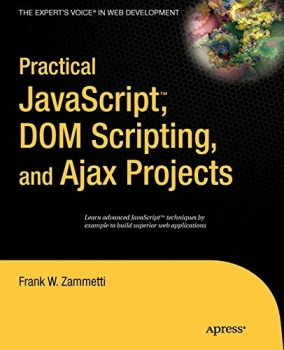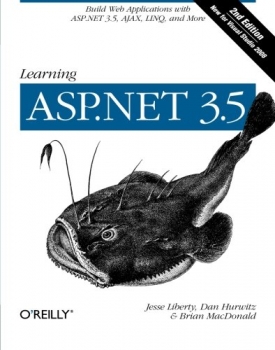وضعیت موجودی موجود
Product details
- Publisher : Peachpit Press; 1st edition (October 3, 2007)
- Language : English
- Paperback : 176 pages
- ISBN-10 : 0321524411
- ISBN-13 : 978-0321524416
کتابBuilding a Web Site with Ajax: Visual QuickProject Guide
From the Author
Ajax has been one of the most significant developments for the Web over the past decade. While almost everyone has heard of it by now, many are still confused by how one applies Ajax to a site. Well, how to apply it correctly, at least. The goal in this book is to provide a primer on what Ajax is, why you might use it, and how to implement it properly.
To achieve this goal, I took one example Web application, for managing employees in departments, and "Ajax-ified" it. Three Ajax features are covered: viewing employees in a department, adding new employees, and searching for employees. While you may not have the need to perform these specific tasks, the underlying theories--returning a large data set via Ajax, POSTing new data, form validation, and searching--are applicable to almost every project. By using these examples, the book is able to hit all the key aspects of what it means to perform Ajax today.
In terms of the code, the book begins by creating the non-Ajax version first, then adding an Ajax layer. There are two benefits to this approach. First, you can ensure that the non-Ajax version is working properly before getting into the more complicated version (Ajax is harder to debug). Second, the Ajax layer is applied so that it "degrades nicely", which is to say the example's core functionality will continue to work even if the user has JavaScript disabled.
For the JavaScript, which is at the heart of Ajax, I explain how to hand write your own code, as opposed to using a framework. While I'm a pretty big fan of jQuery (as a JavaScript framework example), it's worth knowing how to do things the direct way. Plus, you can't really use a JavaScript framework without a good understanding of JavaScript on its own.
The book does assume basic comfortability with HTML, PHP, and MySQL, but the JavaScript is explained in fairly approachable terms.
Thanks for your interest in the book. It is appreciated. And if you purchase it, I hope you like it and find it to be useful and informative.
To achieve this goal, I took one example Web application, for managing employees in departments, and "Ajax-ified" it. Three Ajax features are covered: viewing employees in a department, adding new employees, and searching for employees. While you may not have the need to perform these specific tasks, the underlying theories--returning a large data set via Ajax, POSTing new data, form validation, and searching--are applicable to almost every project. By using these examples, the book is able to hit all the key aspects of what it means to perform Ajax today.
In terms of the code, the book begins by creating the non-Ajax version first, then adding an Ajax layer. There are two benefits to this approach. First, you can ensure that the non-Ajax version is working properly before getting into the more complicated version (Ajax is harder to debug). Second, the Ajax layer is applied so that it "degrades nicely", which is to say the example's core functionality will continue to work even if the user has JavaScript disabled.
For the JavaScript, which is at the heart of Ajax, I explain how to hand write your own code, as opposed to using a framework. While I'm a pretty big fan of jQuery (as a JavaScript framework example), it's worth knowing how to do things the direct way. Plus, you can't really use a JavaScript framework without a good understanding of JavaScript on its own.
The book does assume basic comfortability with HTML, PHP, and MySQL, but the JavaScript is explained in fairly approachable terms.
Thanks for your interest in the book. It is appreciated. And if you purchase it, I hope you like it and find it to be useful and informative.
منابع کتاب کتابBuilding a Web Site with Ajax: Visual QuickProject Guide
از نویسنده
Ajax یکی از مهم ترین پیشرفت های وب در دهه گذشته بوده است. در حالی که تقریباً همه تاکنون در مورد آن شنیده اند، بسیاری هنوز در مورد نحوه اعمال Ajax در یک سایت سردرگم هستند. خوب، حداقل چگونه می توان آن را به درستی اعمال کرد. هدف در این کتاب ارائه مقدماتی در مورد چیستی Ajax، چرایی استفاده از آن و نحوه اجرای صحیح آن است.
برای دستیابی به این هدف، من یک برنامه وب را برای مدیریت کارمندان در بخشها به عنوان مثال انتخاب کردم و آن را با Ajax اصلاح کردم. سه ویژگی Ajax پوشش داده شده است: مشاهده کارمندان در یک بخش، اضافه کردن کارمندان جدید، و جستجو برای کارمندان. در حالی که ممکن است نیازی به انجام این وظایف خاص نداشته باشید، تئوری های اساسی - بازگرداندن مجموعه داده های بزرگ از طریق Ajax، ارسال داده های جدید، اعتبارسنجی فرم و جستجو - تقریباً برای هر پروژه قابل اجرا هستند. با استفاده از این مثالها، کتاب میتواند به تمام جنبههای کلیدی معنای اجرای آژاکس امروزی دست یابد.
از نظر کد، کتاب ابتدا با ایجاد نسخه غیر آژاکس و سپس افزودن یک لایه آژاکس شروع می شود. این رویکرد دو فایده دارد. ابتدا، می توانید قبل از ورود به نسخه پیچیده تر، مطمئن شوید که نسخه غیر آژاکس به درستی کار می کند (اشکال زدایی Ajax سخت تر است). دوم، لایه Ajax به گونهای اعمال میشود که "به خوبی کاهش مییابد"، به این معنی که عملکرد اصلی مثال حتی اگر کاربر جاوا اسکریپت را غیرفعال کرده باشد به کار خود ادامه میدهد.
برای جاوا اسکریپت، که در قلب Ajax قرار دارد، توضیح میدهم که چگونه میتوان کد خود را با دست نوشت، برخلاف استفاده از یک فریم ورک. در حالی که من از طرفداران jQuery هستم (به عنوان یک نمونه چارچوب جاوا اسکریپت)، ارزش این را دارد که بدانیم چگونه کارها را به طور مستقیم انجام دهیم. به علاوه، شما واقعاً نمیتوانید از یک چارچوب جاوا اسکریپت بدون درک خوب جاوا اسکریپت به تنهایی استفاده کنید.
این کتاب راحتی اولیه را با HTML، PHP و MySQL فرض میکند، اما جاوا اسکریپت با شرایط نسبتاً قابل دسترس توضیح داده شده است.
با تشکر از علاقه شما به کتاب قابل تقدیر است. و اگر آن را خریداری کردید، امیدوارم که آن را دوست داشته باشید و مفید و آموزنده باشد.































ارسال نظر درباره کتابBuilding a Web Site with Ajax: Visual QuickProject Guide